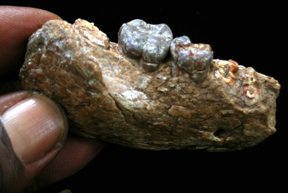 Fossil evidence
from the Late Miocene and Early Pliocene, the time period about 5 million years
ago when the last common ancestor between humans and chimpanzees lived, is rare.
Researchers excavating in Ethiopia, however, have recently discovered the remains
of nine individual hominids from the Early Pliocene, thus helping scientists
understand more of the human evolution puzzle.
Fossil evidence
from the Late Miocene and Early Pliocene, the time period about 5 million years
ago when the last common ancestor between humans and chimpanzees lived, is rare.
Researchers excavating in Ethiopia, however, have recently discovered the remains
of nine individual hominids from the Early Pliocene, thus helping scientists
understand more of the human evolution puzzle.This fossilized hominid lower jaw bone is about 4.5 million years old and is one of 30 fossils recently found in Ethiopia that are revealing more about human evolution. Courtesy of Sileshi Semaw.
More than 30 bones — jaws, teeth and a few pieces of fingers and toes — of Ardipithecus ramidus were recovered by an international team of researchers in the Afar region in northern Ethiopia, as reported in the Jan. 20 Nature. Since fossils of it were first discovered more than a decade ago, A. ramidus has been thought to be the first hominid that lived following the genealogical split with chimps, humankind’s closest living relative.
The researchers dated the hominid fossils to between 4.51 and 4.32 million years old. Alongside the A. ramidus fossils were fossils of monkeys, mole rats and cow-like grazers, as well as evidence indicating that the ecosystem was diverse in the Early Pliocene. There were swamps, springs and streams, and woodland or grassy woodland areas, and it looks like at least parts of the region experienced some seasonal drought, the researchers wrote. But the team says that it needs further evidence that more tightly associates the hominids with a specific environment before they can determine exactly in which habitat they lived.

